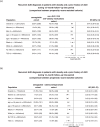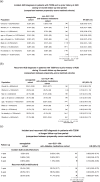Associations of semaglutide with incidence and recurrence of alcohol use disorder in real-world population
- PMID: 38806481
- PMCID: PMC11133479
- DOI: 10.1038/s41467-024-48780-6
Associations of semaglutide with incidence and recurrence of alcohol use disorder in real-world population
Erratum in
-
Author Correction: Associations of semaglutide with incidence and recurrence of alcohol use disorder in real-world population.Nat Commun. 2024 Jun 18;15(1):5177. doi: 10.1038/s41467-024-49655-6. Nat Commun. 2024. PMID: 38890337 Free PMC article. No abstract available.
Abstract
Alcohol use disorders are among the top causes of the global burden of disease, yet therapeutic interventions are limited. Reduced desire to drink in patients treated with semaglutide has raised interest regarding its potential therapeutic benefits for alcohol use disorders. In this retrospective cohort study of electronic health records of 83,825 patients with obesity, we show that semaglutide compared with other anti-obesity medications is associated with a 50%-56% lower risk for both the incidence and recurrence of alcohol use disorder for a 12-month follow-up period. Consistent reductions were seen for patients stratified by gender, age group, race and in patients with and without type 2 diabetes. Similar findings are replicated in the study population with 598,803 patients with type 2 diabetes. These findings provide evidence of the potential benefit of semaglutide in AUD in real-world populations and call for further randomized clinicl trials.
© 2024. The Author(s).
Conflict of interest statement
The authors declare no competing interests.
Figures



Similar articles
-
Association of semaglutide with risk of suicidal ideation in a real-world cohort.Nat Med. 2024 Jan;30(1):168-176. doi: 10.1038/s41591-023-02672-2. Epub 2024 Jan 5. Nat Med. 2024. PMID: 38182782 Free PMC article.
-
Semaglutide and Tirzepatide reduce alcohol consumption in individuals with obesity.Sci Rep. 2023 Nov 28;13(1):20998. doi: 10.1038/s41598-023-48267-2. Sci Rep. 2023. PMID: 38017205 Free PMC article.
-
Weight loss response in patients with obesity treated with injectable semaglutide in a real-world setting.Endocrine. 2024 Feb;83(2):392-398. doi: 10.1007/s12020-023-03534-0. Epub 2023 Sep 21. Endocrine. 2024. PMID: 37735340
-
Semaglutide as a promising antiobesity drug.Obes Rev. 2019 Jun;20(6):805-815. doi: 10.1111/obr.12839. Epub 2019 Feb 15. Obes Rev. 2019. PMID: 30768766 Review.
-
Cardiovascular Safety and Benefits of Semaglutide in Patients With Type 2 Diabetes: Findings From SUSTAIN 6 and PIONEER 6.Front Endocrinol (Lausanne). 2021 Mar 29;12:645566. doi: 10.3389/fendo.2021.645566. eCollection 2021. Front Endocrinol (Lausanne). 2021. PMID: 33854484 Free PMC article. Review.
Cited by
-
Harnessing Evolution and Biomimetics to Enhance Planetary Health: Kidney Insights.J Am Soc Nephrol. 2025 Feb 1;36(2):311-321. doi: 10.1681/ASN.0000000582. Epub 2024 Nov 22. J Am Soc Nephrol. 2025. PMID: 39607684 Review.
-
Response to the letter titled "Targeting dementia prevention with semaglutide: the case for APOE4 homozygotes".Alzheimers Dement. 2025 Jun;21(6):e70423. doi: 10.1002/alz.70423. Alzheimers Dement. 2025. PMID: 40572020 Free PMC article. No abstract available.
-
Newer glucose-lowering drugs reduce the risk of late-onset seizure and epilepsy: A meta-analysis.Epilepsia Open. 2024 Dec;9(6):2528-2536. doi: 10.1002/epi4.13091. Epub 2024 Nov 2. Epilepsia Open. 2024. PMID: 39487832 Free PMC article.
-
MetALD: Clinical aspects, pathophysiology and treatment.JHEP Rep. 2024 Nov 2;7(2):101250. doi: 10.1016/j.jhepr.2024.101250. eCollection 2025 Feb. JHEP Rep. 2024. PMID: 39897615 Free PMC article. Review.
-
Glucagon-like peptide-1 analogues reduce alcohol intake.Diabetes Obes Metab. 2025 Mar;27(3):1601-1604. doi: 10.1111/dom.16152. Epub 2025 Jan 2. Diabetes Obes Metab. 2025. PMID: 39748222 Free PMC article. No abstract available.
References
-
- SAMHSA, Center for Behavioral Health Statistics & Quality. SAMHSA, Center for Behavioral Health Statistics and Quality. 2021 National Survey on Drug Use and Health. Table 5.6A—Alcohol use disorder in past year: among people aged 12 or older; by age group and demographic characteristics, numbers in thousands, https://www.samhsa.gov/data/sites/default/files/reports/rpt39441/NSDUHDe... (2021).
MeSH terms
Substances
Grants and funding
- R01 AG057557/AG/NIA NIH HHS/United States
- CA221718, CA043703, CA2332216/U.S. Department of Health & Human Services | NIH | National Cancer Institute (NCI)
- R01 AA029831/AA/NIAAA NIH HHS/United States
- R56 AG062272/AG/NIA NIH HHS/United States
- AA029831/U.S. Department of Health & Human Services | NIH | National Institute on Alcohol Abuse and Alcoholism (NIAAA)
LinkOut - more resources
Full Text Sources
Medical
Miscellaneous

